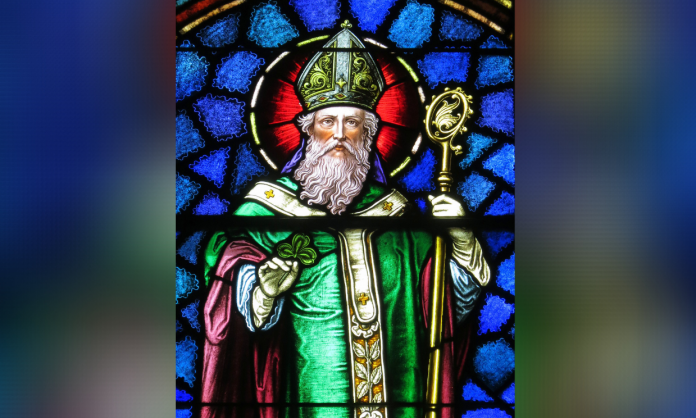By Michael Sheane
Saint Patrick is Ireland’s national saint, both for the north and south of the country. His feast day is March 17th, the date of his death. It is claimed that he made a great impact on Irish society, but modern research reveals that his missionary activities were confined to the northeast of the island.
Tradition holds that he was born at Dumbarton, west of Scotland, about 385 AD, into a middle class family, when the Roman Empire in Britain was well in decline. He started his mission to the Gaels about 432, having received a blessing from Pope Celestine I to convert the Pagan druids of Ireland. He died about 451; others think later, and he was well into his seventies when God called him.
He has left us two works outlining his faith in the Catholic Church, his Confession written in Latin, but there are few biographical details in it, nor in is his Letter to Coroticus, a British chieftain, who was persecuting his Catholic subjects.
Later in 7th century are the works of Tírechán and Muirchú that detail many miracles surrounding Patrick or Succat. This article hopes to outline his mission to the Gaels, and why he set up a Gaelic Church in Ireland, a branch of the European Church of Rome, based in Italy.
The Patrick of stained glass comprises mainly of the legends dealing with Patrick. Many windows were crafted in the early 20th century in Irish studios such as An Túr Gloine. The miracles surrounding the saint were the most popular themes featured in the stained glass. There is quite a lot of good English work in the stained glass, providing a more straightforward view of the Apostle of Ireland.
The patrician legends surrounding Patrick may not be factual, but they carry the spirit of the Gaelic Church. In Christchurch Cathedral, Dublin, is a window by Clayton and Bell (1878), which features the early life of Succat, detailing his birthplace as Bannevem Taburniae, but the location of this is uncertain.
Patrick’s father was a deacon and his grandfather, Potitus, a priest. The stained glass window in Christchurch perhaps reflects the passion of Succat during his slavery at Slemish in Co. Antrim, in the mid-Antrim kingdom of Dalraida, where he spent about six years in captivity. One theory is that he escaped from Slemish with the local king’s blessing, for he may have been a favourite slave.
Also, for some reason, Miliucc, the local king, committed suicide upon Patrick’s return from the Rome of Pope Celestine. The window in Christchurch reflects the belief that he did not know the one true God. His slavery at Slieve Mish, or Slemish, was spent tending sheep. The beautiful stained glass window in St. Patrick’s Cathedral, Armagh (c. 1865) is by Lavers Barraud & Westlake.
It inspired the belief in the saint’s setting up of Saul as his first church in Éire, the local king, Dichu, being his first convert. The stained glass window in the cathedral depicts Patrick laying the foundation stone of the Saul chapel, later to become an abbey.
We now turn to a more humble stained glass window made by Wilhelmina Geddes in 1925, featuring Patrick in the Kingdom of Laharna or Larne. The window shows the saint confronting the druids in the valley of the Boyne River, at Tara, the seat of the High Kings of Ireland. Patrick made the assumption that the local king’s subjects would follow his conversion to the Catholic Church.
The 1914 window of Michael Healy in the Church of the Sacred Heart (RC) in Donnybrook, Co. Dublin, tells of Patrick’s mission to the people who, until then were worshipping idols. There is much colour work, with the use of red, green and yellow, along with other paintings. Succat holds high the cross of salvation.
There is another window by Wilhelmina Geddes (1923) in the Church of Ireland, Larne, Co. Antrim, and it shows the saint as an old man with a long white beard on the eve of his death. It captures the historical Patrick better than any other stained glass window. His clothes are rich in colour and it recalls his mission to the Gaels.
In Co. Wicklow, there is a window by Clayton & Bell (1899) in the St. Saviour’s Church at Arklow. It is a Te Deum Laudamus window, showing Christ’s majesty, surrounded by many saints, angels and churchmen. Patrick and Columba are placed in the lower section alongside Augustine of Canterbury. It depicts Patrick as the central figure in the Christianity of Ireland. His feast day has been celebrated on the Continent since the 9th century, and also celebrated everywhere there is an Irish population, especially the United States.
There are five windows that venerate the saint, and they are illuminated as the sun breaks through the glass, lighting up the church and its devout Catholics. The Roman Catholic Church at Kilcurry, Co. Meath, is by Sarah Purser, and deals with the saint’s associations with Armagh. It shows Patrick in the green fields of Co. Louth.
Patrick may have travelled as far away as Co. Mayo and the woods of Foclut that were close to the western sea. He had been inspired here and heard a voice say, “Come, holy youth, come again and walk amongst us”, i.e. the Gaels of Ireland with his Gaelic Church.








